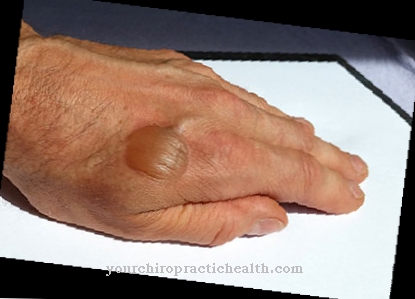A Affect lability is characterized by strong and rapid fluctuations in the basic mood. Even the slightest stimulus can trigger significant mood swings. The mood changes can be an expression of normal hormonal changes as well as pathological organic processes.
What is affect lability?

© Sondem - stock.adobe.com
The affect lability is characterized by a rapid change in the basic mood, which often occurs without any noticeable external cause. This mental state is also known as mood lability. The affected person is aware of the mood swings, but does not experience them as pathological or embarrassing. In the case of affect lability, there is a rapid change in emotions (affects), whereby the duration of the emotions is usually only very short.
So anger can quickly turn into sadness or sadness quickly into joy. The affect labile reacts excessively strongly to externally offered affects. He can no longer differentiate the feelings arriving from outside and is unable to control his reactions to them. The emotions, for example, quickly change from “cheering up high” to “sad to death”.
These mood swings can be completely normal in certain phases of development or hormonal changes. This applies to childhood, puberty, menopause or the hormonal changes during menstruation, among other things. Mood changes can also occur quickly during pregnancy. However, there are also many pathological processes that are associated with affect lability.
causes
The causes of affect lability can be varied. Often these are normal reactions that occur during a hormonal change. Women before menstruation or during pregnancy are particularly affected. Rapidly changing affects are also normal in children. Mood swings are particularly pronounced during puberty. The same is true for women during menopause.
During the hormonal change or during growth processes, physical abnormalities often occur, which are noticeable externally as mood swings. However, there are also a number of physical and mental illnesses that are associated with severe affect lability.
You can find your medication here
➔ Medication to lighten the moodSymptoms, ailments & signs
Affect labilities are particularly extreme in bipolar affective disorder, which was formerly also known as manic-depressive illness. In this disorder, phases of depressed mood alternate with strongly euphoric phases. Between these phases, the patient's condition can temporarily return to normal until the next episode of the disease occurs.
In the depressive phases, the affected person is sometimes even suicidal, while in the manic state, among other things, he develops feelings of omnipotence. In this clinical picture, phases of increased drive alternate with phases without drive. Even depression without mania is characterized by mood swings in some patients.
Especially in the morning after getting up, the mood is at its absolute low. However, mood improvement often occurs during the day. Mood swings often occur even with borderline disorders. Even the smallest of occasions are enough to change the mood. Furthermore, affect labilities often occur in the early phases of schizophrenia. Many forms of personality disorders are also associated with affective lability.
Of course, strong psychological stress in the event of stress or conflicts can also lead to significant mood swings. Another cause of affect lability can be the onset of dementia such as Alzheimer's. With addictions such as alcoholism or drug addiction, there is always an affect lability. Other causes of strong mood swings include brain tumors or hormonal diseases such as an overactive thyroid.
Diagnosis & course
If you have severe and persistent mood swings, you should definitely consult a doctor. The doctor can then clarify whether the affect lability occurs as part of a normal hormonal change or whether it is an expression of a pathological process. A comprehensive anamnesis is particularly important for this.
The doctor asks, among other things, how frequent and how severe the mood swings are, whether there are certain triggers and which additional symptoms occur. In addition, certain cognitive tests can be carried out, which provide information on whether an incipient dementia, depression or another mental disorder is present.
To rule out physical causes of affect lability, neurological examinations are carried out and the hormone level or vitamin status is determined. It also depends on the accompanying symptoms whether certain imaging procedures such as MRI, CT or an EEG and an EKG are necessary.
Complications
In itself, it is difficult or even impossible to name "complications" that can arise in the context of affect lability. It should be pointed out here that affect lability can occur in the context of various mental illnesses, but also as a normal circumstance of a certain stage of development. The instability of the affects is therefore only a symptom and not an independent disease and, moreover, does not always indicate a disease.
On the basis of the assumption that affect lability occurs in the context of a mental illness, however, it can be said that some quite dangerous behaviors arise from this, which in the broadest sense can be understood as "complications". This includes, for example, excessive aggressiveness that can result from uncontrollable anger. Such an uncontrollable anger can occur relatively easily in the context of an affect lability and under certain circumstances induce the person concerned to behave in an unusual way.
The lack of control of affects or moods is the hallmark of affect lability and therefore cannot be seen as a complication of this. Complications only arise from these uncontrollable moods and emotions. Self-injurious or suicidal behavior can also occur together with affect lability. However, many behaviors are more likely to be seen as additional symptoms than as complications or consequences. Ultimately, it can be said that various "undesirable" and sometimes dangerous behaviors can result from affect lability.
When should you go to the doctor?
In the case of affect lability, it is important to note how long it lasts and at what time intervals it recurs. A doctor should always be consulted if the affect lability leads to a burden on the person concerned, which he or his environment perceives as problematic. Depending on the severity and cause, behavior tips can be very helpful, especially at the beginning.
In more severe cases, antidepressants are prescribed. The problem with affect lability is that those affected often react very difficultly to advice from a doctor's visit. Usually there is a gradual process of social isolation that lasts for years. The vital tasks can then often no longer be mastered from one day to the next. Once this point has been reached, the patient is no longer able to consult a doctor on his own.
Therefore, timely help is required in the case of affect lability. A sure instinct and good empathy in dealing with the person affected are required. Since affect lability is often very difficult to manage for relatives of a sick person, it is advisable for them to consult a doctor. In a consultation, you will receive valuable advice from a specialist that can be helpful in coping with the changing affects in everyday life. Relationships are explained and the stressful situations for the environment can be reduced.
Doctors & therapists in your area
Treatment & Therapy
If affect lability occurs during pregnancy, puberty or in the premenstrual phase, therapy is not necessary. Mood swings are common during these phases. However, if the affect lability is persistent and cannot be associated with a physical adjustment phase, it must definitely be treated. Therapy then depends on the underlying disease.
Bipolar disorder is treated with antidepressants. These active ingredients intervene directly in the brain metabolism and help to lighten the mood. In the case of many mental illnesses, the cause must also be investigated as part of psychotherapy. Often it is triggered by a traumatic experience in childhood. An effective therapy is often only possible after its discovery. With organic causes, the affect lability disappears after the disease has healed.
Outlook & forecast
The prospect of improvement in affect lability depends on the cause of it. Affect lability, which occurs as a symptom of physical illnesses, usually disappears with them or remains with them (in the case of permanent organic disorders).
In children, affect lability can be normal. It improves with age. Even in adults, sentimentality isn't always a sign of illness or a deeper psychological problem. This is especially true if it only occurs in certain situations - for example during an emotional film.
In premenstrual syndrome (PMS) in women, affect lability can follow a cyclical course. In this context, it is a recurring symptom that, however, only rarely leads to permanent stress.
There is a good prognosis for postpartum depression after childbirth, especially if the social environment is stable. However, previous depression and other stressful factors can worsen the prospect of a speedy recovery.
The prognosis for personality disorders is rather poor. However, with appropriate treatment and sufficient motivation, significant improvements can be achieved in many cases. The personality disorder almost always weakens with age. Even with personality disorders, a stable environment has a positive effect on the course of the disease. Work, family and friends play a central role in this.
You can find your medication here
➔ Medication to lighten the moodprevention
Because of the many possible causes, no specific recommendations can be given to prevent affect lability. A healthy lifestyle with a balanced diet, plenty of exercise and little stress reduces the likelihood of affective instability.
Aftercare
With affect lability, follow-up care proves to be relatively difficult and cannot be carried out easily. First and foremost, the disease must be treated yourself in order to avoid further complications and complaints. A complete healing of the affect lability is not always possible.
In most cases, the person affected has to seek psychological treatment for this disease. Family and friends can also point out the symptoms of the disease to the patient and recommend therapy to those affected. This should also be carried out until the symptoms of affect lability have completely disappeared.
Conversations with friends and family can also be very useful in order to alleviate the symptoms and improve the quality of life of the person affected. Contact with other patients with affect lability can also have a positive effect on the further course of the disease, as this can often lead to an exchange of information.
Since medication also has to be taken, regular intake should be ensured. Possible interactions must also be taken into account. The intake should continue until the disease has been cured.
You can do that yourself
Depending on the underlying disease, those affected can positively influence the course and extent of their affect lability on various levels. Anything that supports the balance between sympathetic and parasympathetic processes in the body is effective. This includes: a healthy, balanced diet with a sufficient supply of vitamins and minerals, appropriate handling of stress, sporting activities and plenty of exercise in the fresh air. Consciously perceived nature experiences, various relaxation methods as well as sufficient quality and quantity of sleep promote the ability to regenerate quickly as the basis for a more balanced everyday life.
In principle, it is helpful to exchange ideas with other affected persons, for example in self-help groups or online forums. In addition to conventional medical care, some patients benefit from alternative and naturopathic treatments and from dietary supplements tailored to the underlying disease. However, these must not be taken without medical advice.
Hobbies, pets and deliberately used time-outs, in which the ability to enjoy life is trained, also make an important contribution to establishing the balance between tension and relaxation in everyday life. It can be a sensible goal of supportive self-therapy to accept the uncontrollable mood as part of one's life and to recognize it as such. A combination of the above-mentioned self-help modules works most effectively according to individual standards in coordination with the therapeutic requirements of the main underlying disease.



.jpg)
.jpg)







.jpg)



.jpg)










.jpg)
